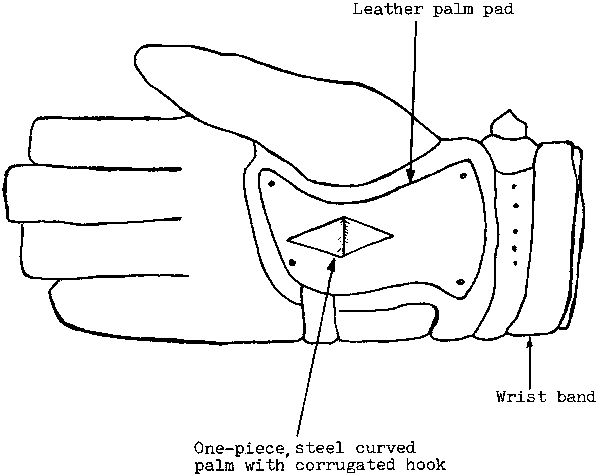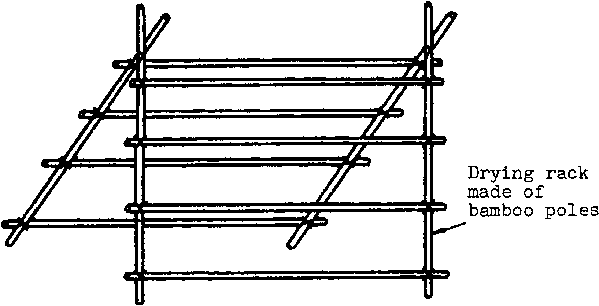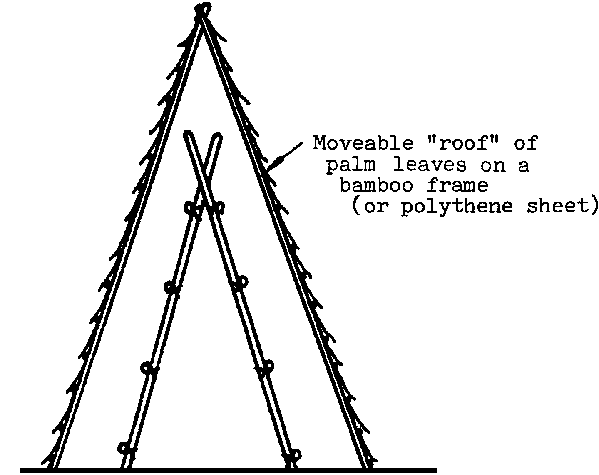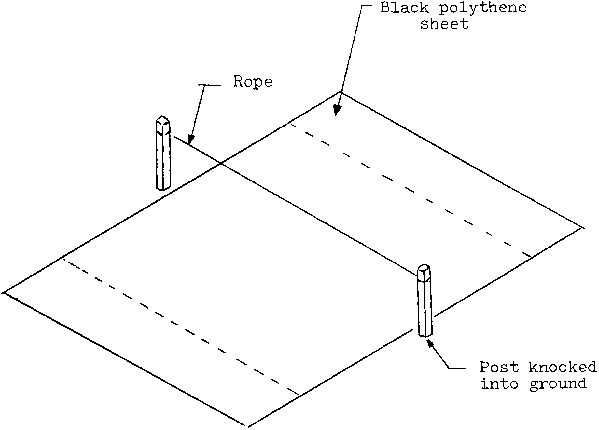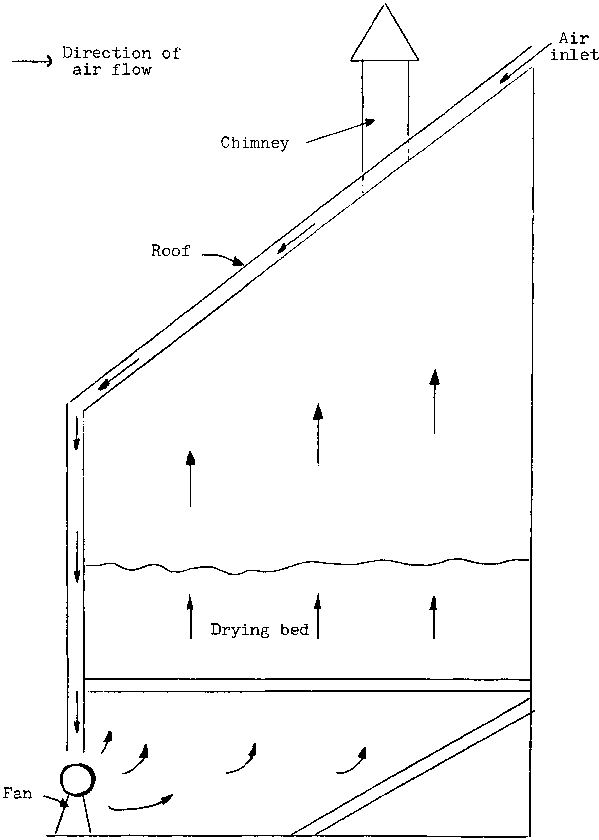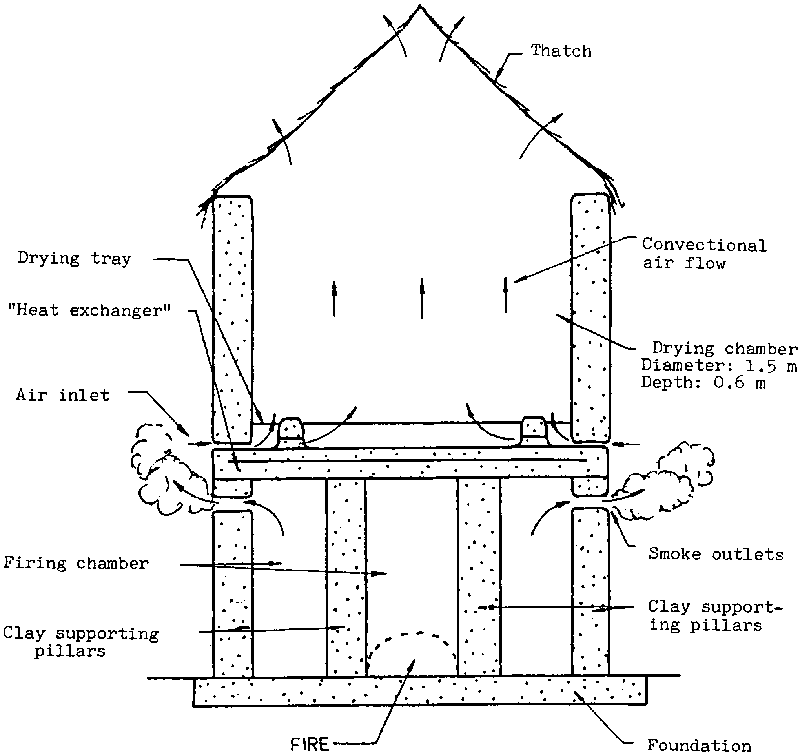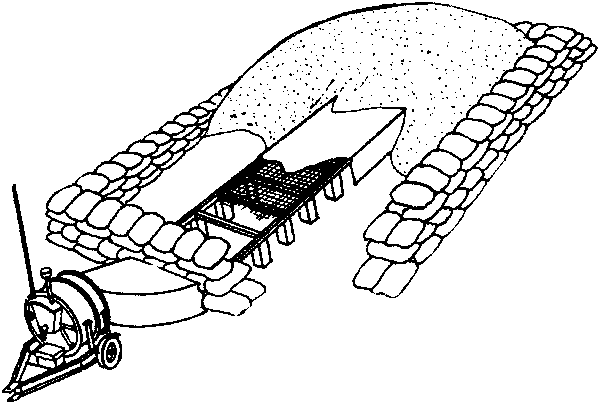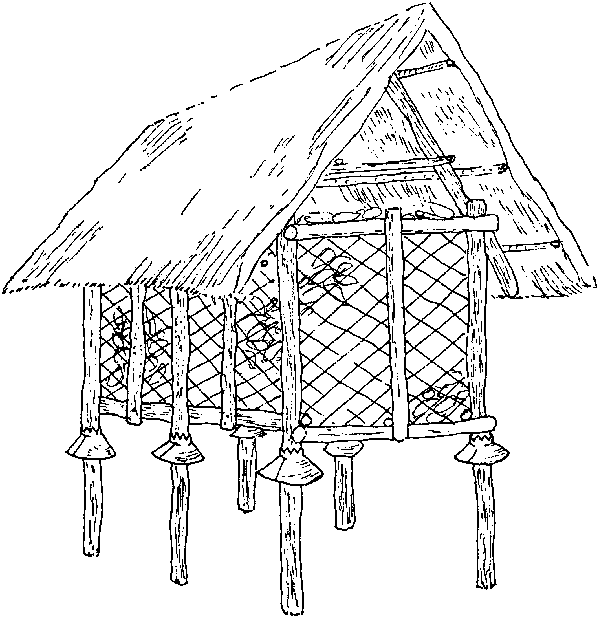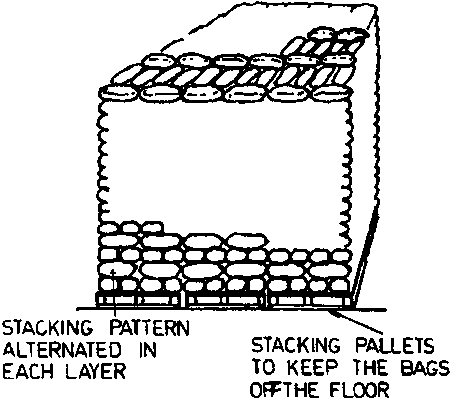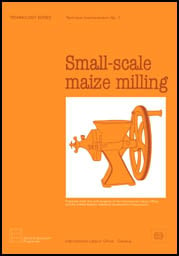
CHAPTER II. GRAIN PREPARATION[edit | edit source]
I. INTRODUCTION[edit | edit source]
A number of operations must be carried out prior to the milling of maize grain, including the following:
- harvesting of the maize cobs;
- drying of cobs prior or after husking;
- husking;
- shelling; and
- storage of dried grain whenever necessary.
The above sequence of operations may be altered by, for example, shelling the cob after harvesting or husking, then drying the shelled grain for storage. The drying of maize before shelling is recommended whenever it must be stored over a prolonged period of time before milling since the leaf sheaths protect the grain against insect infestation and breakage. On the other hand, the drying of maize on the cob requires a longer drying time than that of shelled maize. Thus, the decision to dry the grain before or after shelling will depend to a large extent on its ultimate use.
The various operations preceding milling are briefly reviewed in this chapter, with the exception of shelling which is described in detail in Chapter III. Since this memorandum is mostly concerned with milling technologies used in small-scale production units (custom and merchant mills), a number of the operations listed above may not be carried out by these units. For example, custom mills usually process the dried grain brought by the customers, and do not engage in husking, shelling or drying of maize. However, it is conceivable that some small-scale mills, particularly merchant mills located in urban areas, may carry out some of the operations. This is the reason for including this chapter on grain preparation. However, since a separate memorandum on grain storage and drying is also being prepared, these two operations will not be covered in detail in this chapter.
Small-scale mills may undertake the various operations which precede milling according to one of the following five sequences:
- Husking - drying - storage on the cob - shelling as required;
- Husking - drying - shelling - storage as shelled grain;
- Husking - shelling - drying - storage as shelled grain;
- Drying - husking - storage on the cob - shelling as required; and
- Drying - husking - shelling - storage as shelled grain.
Depending on circumstances, one or the other of the above sequences may be preferred. Weather conditions, availability of storage, and the duration of the storage period, the price and availability of fresh or dried cobs, etc. will generally dictate the choice of the most appropriate sequence.
II. HUSKING (REMOVAL OF LEAF SHEATHS)[edit | edit source]
The leaf sheaths (fresh or dry) may be removed manually or mechanically. In the latter case, the removal of leaf sheaths is generally part of the shelling operation, the powered maize shellers being equipped with an appropriate husking element. Mechanical husking is not generally appropriate for small-scale mills since the capacity utilisation of the husking and shelling equipment is generally too large for these mills.
Manual husking involves the stripping of leaf sheaths with either the bare fingers or with a glove equipped with a husking hook. The latter improves labour productivity while protecting the fingers. A typical husking hook is shown in figure II.1. The hook is first inserted into the leaf sheaths at the tassel end of the cob and then moved towards the cob base, thus stripping away the leaf sheaths from the grain. The husking hook is particularly useful when husking dried cobs since the leaft sheaths are much harder to strip away than those of fresh cobs.
Figure II.1 A typical husking hook
III. DRYING[edit | edit source]
There is no definitive method for the drying of maize since each method depends on a number of factors, such as the level of maize production, the intended use of the grain, the capital and expertise available, fuel availability and the local weather after harvest. In this section, the principles involved in maize drying are summarised and a small selection of the available drying methods are briefly described.
Maize must be adequately dried before subsequent storage to prevent germination of the grain, the growth of micro - organisms and insect infestation. Most drying processes, either of cob maize or shelled grain, take place at or near the point of maize production.
During the drying process, moisture which evaporates from the wet grain is rapidly absorbed into the drying air until an equilibrium state is reached where no further moisture is lost. The final grain moisture content is termed the Â"equilibrium moisture contentÂ" for specific ambient conditions. The rate at which drying takes place depends upon the moisture content of the grain and the flow rate, temperature and humidity of the drying air.
The most important factor in the drying of grain is the air flow rate over or through the grain rather than the air temperature. However, drying may be accelerated by increasing the air temperature. The latter should be kept below some maximum value depending upon the intended end-use of the grain. For milling purposes, temperatures above 60°C should be avoided since milling and nutritional characteristics may be adversely affected.
III.1 Moisture content determination[edit | edit source]
For safe storage, the moisture content of grain should be reduced to 13 per cent or less. It is therefore important to measure the moisture content before ending the drying cycle.
Methods of moisture content determination used in large-scale plants are complicated, expensive and inappropriate for small-scale mills. The latter should therefore rely on visual inspection and simple experiments, such as the pressing of the grain with the thumb nail or its crushing between the teeth. The drier the grain, the more resistance it offers to this pressure. An alternative, simple and effective method involves the shaking of a cupfull of shelled grain for two to three minutes in a screw-top bottle containing a tea-spoon of salt. The grain is dry enough for storage if the salt does not lump or stick to the sides of the jar (O'Kelly, 1979).
III.2 Drying methods[edit | edit source]
Drying of maize may be achieved by one of three basic methods or a combination of these: sun drying, solar drying and artificial drying. The drying of maize on the cob, or of shelled grain dictates the choice of drying operations in each of these methods. The main characteristics of the latter are summarised in table II.1
III.2.1 Sun drying
Since most areas of developing countries benefit from sufficient sunshine during the post-harvest period, dependence upon the sun for drying grain is the cheapest and most common practice amongst maize farmers.
Cob maize, either husked or unhusked, is often dried in narrow cribs with open wall construction to allow natural ventilation through the cobs. Under suitable climatic conditions, and provided that there is no excessive restriction to the air flow, the cobs dry to a safe moisture content without the development of surface mould or insect infestation. These cribs are also commonly used for the temporary storage of dried cobs.
Unhusked maize cobs are often tied by the tassels into small bundles and hung from trees or exterior house rafters to dry. Alternatively, simple racks, made from horizontal bars supported by inclined bamboo poles, may be used (see figure II.2). The cobs are hung from the horizontal bars by their tassels. In the event of a sudden shower, a similar but slightly taller rack covered with polythene sheeting or large leaves, can be placed over the first rack (see figure II.3).
Major characteristics of the sun, solar and artificial drying systems
|
Artificial | |||||
|
Sun |
Solar |
Natural convection |
Forced convection | ||
|
Ambient air |
Heated air | ||||
|
Throughput |
Very low |
Moderate |
Low |
Moderate |
High |
|
Scale and capital cost |
Very low |
Moderate |
Low |
Moderate |
High |
|
Skill required for operation |
Low |
Moderate |
Moderate |
Moderate |
High for some |
|
Labour requirements for operation |
High |
Moderate |
High |
Low |
Low |
|
Technology and maintenance requirements |
Minimal |
Moderate |
Low |
High |
High |
|
Dependency upon climate |
Total |
Major |
Nil |
Slight |
Nil |
|
Dependency upon combustible fuel |
Nil |
Nil |
Total |
Nil |
Total |
|
Dependency upon external power (electricity) |
Nil |
Total |
Nil |
Total |
Total |
|
Control of drying |
Nil |
Moderate |
Low |
High |
High |
|
Susceptibility to grain damage |
Moderate |
Low |
High |
Low |
Low |
|
Protection against insect or microbial infestation |
Low |
Moderate |
Moderate |
Moderate |
High |
Figure II.2 Simple rack for the sun drying of unhusked maize cobs
Figure II.3 Drying rack inside a moveable Â"roofÂ"
Maize grain, shelled directly after harvest, may be spread on the ground and sun-dried to a safe moisture content. Drying under these conditions can be accelerated by placing the grain on a black surface, such as a black plastic sheeting (see figure II.4). Two posts are knocked into the ground on either side of the plastic sheet and a rope or bamboo pole is suspended between them. The grain is spread over the sheet with the two ends of the latter left uncovered. In the event of a rain shower, the two ends can be lifted and pegged to the rope, thus forming a simple tent over the grain. This type of drying system requires frequent mixing of the grain in order to prevent over-heating of the latter.
III.2.2 Solar dryers
Solar dryers are often advocated for grain drying (Soza, 1979). These dryers are particularly useful in areas with high rainfall and humidity during the post-harvest period. They make use of the limited amount of sunshine for a rapid drying of the crop.
Figure II.5 shows one type of solar dryers used in large-scale operations. These dryers are made of three parts:
- a solar collector to heat the drying air;
- a drying bed system which is not exposed to the sun; and
- a fan or similar device for providing a flow of air through the solar collector and drying bed.
These dryers were originally designed to improve the drying rate of maize grain contained in conventional bins. The roof and sun-facing wall of the bin are converted into a solar collector by painting them black to enhance the absorption of solar radiation. An air duct is formed by fixing wooden panels under the roof and inside the sun-facing wall. The heat absorbed by the black surface is transmitted by conduction to the air within the duct thus raising its temperature. A fan at the base of the air duct draws the warm air from the duct, and forces it through the drying bed. After passing through the grain, the drying air exhausts through the chimney in the roof.
Other types of solar dryers have been developed for the drying of maize and other grains. Some of these dryers are described in detail in a publication by VITA (1977).
Figure II.4 Improved sun drying of shelled maize grain
Source: O'Kelly (1979)
Figure II.5 A forced convection solar dryer
Source: Buelow (1961)
III.2.3 Artificial drying
Despite the fact that solar energy is often utilised for the drying of maize (e.g. on the cob or as shelled grain), unfavourable climatic conditions will often prevent drying to a sufficiently low moisture content for safe storage. Artificial drying, with or without a supplementary heat source, is therefore necessary.
Considerable attention has been paid to the design of simple dryers for the subsistence level farmer. One such dryer, which can be constructed from easily available materials, is illustrated in figure II.6. It is essentially a thick walled clay cylinder with a thatched roof. At mid height, a clay floor, supported by clay pillars, serves as a Â"heat exchangerÂ" and as a means of supporting the material to be dried. Beneath this 'heat exchanger' is the firing chamber in which wood or agricultural waste is burned to generate the heat required for the drying process. Small smoke outlets in the firing chamber can be closed to reduce combustion. Air inlets in the upper drying chamber allow air to be drawn into the dryer and be heated as it flows through the 'heat exchanger'. The heated air exhausts through the thatch after passing through the rack of drying maize.
An alternative to the natural convection system described above consists in using fan-powered, forced convection systems with or without a supplementary heat source. The fans can be driven by electricity, diesel, petrol or any other rotative power source. Grain may be dried loose in the field in a system similar to that illustrated in figure II.7. Warm air from a fan and heater unit is channelled via a flexible duct into the air space beneath a drying frame covered with hessian sacks. The grain is piled over the frame to a depth of 1.8 m. It is contained within a barrier of grain-filled sacks approximately 1.2 m away from the sides and one end of the drying frame. This system can also be used for drying grain in sacks which should not be more than three-quarters full (see figure II.8). For grain with a moisture content greater than 20 per cent, the sacks should be laid two rows wide around the frame and up to five layers deep over it. With grain at a moisture content of less than 20 per cent, loading can be continued to a greater depth. Since these types of dryers are exposed, a large waterproof cover should be available for protection in the event of rain.
Figure II.6 Fuel fired dryer
Source: O'Kelly (1979)
Figure II.7 Ventilated floor drying of loose shelled grain
Source: R.A. Lister Ltd.
Figure II.8 Ventilated floor drying of sacked grain
Source: R.A. Lister Ltd.
IV. TEMPORARY STORAGE OF DRIED MAIZE[edit | edit source]
IV.1 Moisture content and safety from moulds[edit | edit source]
To minimise the risk of mould damage, maize grain should have a moisture content below 13 to 13.5 per cent (wet weight basis) for storage in bags, or below 12 to 12.5 per cent for bulk storage in bins or silos. In general, the drier the grain, the lower the risk for grain damage. However, drying below 12 per cent may lead to increased breakage of grains during handling, and will also require extra conditioning of the grain for milling. Maize grain on the cob can be stored, safe from mould damage, in open-sided cribs. In this case, the moisture content need not be less than 13.5 per cent. Cobs can be loaded into the crib at high moisture content and allowed to dry by natural aeration. Cribs should be of reduced width if used for drying in humid climates.
IV.2 Prevention against insect damage[edit | edit source]
Dry maize grain, clean and free from evident damage and insect infestation at the time of delivery, will not normally suffer severe insect damage if stored for 3 to 4 months or less. High grain damage levels, including broken grains, increase the susceptibility to insects and moulds, high-yielding varieties being commonly more susceptible to insect pests than traditional varieties. If the initial percentage of insect-infested kernels is about one per cent, the level of damage in 3 to 4 months storage at 20-25°C is likely to rise, at least to about 20 per cent. Such a level represents a 2 to 3 per cent loss of dry weight. At higher storage temperatures (up to about 30°C), the loss is increased, and at mean temperatures of 30°C, it could be more than doubled.
Grain with evident infestation should be disinfested by fumigation with an approved insecticidal gas (e.g. phosphine or methyl bromide, which are approved for this purpose in most countries), or by spraying the grain itself with a locally approved insecticidal grain protectant. A suitable dilute powder formulation can be used instead, and applied by mechanical admixing, if a suitable spray formulation is unavailable or inappropriate to the adopted grain handling system. In general, sprays are preferable for grains handled in bulk, since they can usually be applied to the grain flow at a convenient point in the grain conveying system. Grain in bags can often be more easily treated by shovel-mixing a powder with the grain from each lot of 10 to 20 bags.
IV.3 Prevention against rodent and bird damage[edit | edit source]
Prevention against bird or rodent damage requires scrupulous attention to site hygiene and the maintenance of effective screens or other barriers to prevent the entry of these pests into the store. Supplementary measures may be needed from time to time to eradicate rodents. Poison-baiting with anti-coagulant rodenticides is the preferred method. Poison-baiting and other techniques for bird control are not recommended and should not be necessary if stores are effectively screened against birds.
IV.4 Storage systems[edit | edit source]
The common modes of storage and the systematic procedures necessary for their success are indicated in figures II.9 and II.10. Whatever the procedure adopted, management should always place great emphasis on the need for high standards of store maintenance, store and site hygiene, quality control at intake for storage, etc. The systems described in this section constitute a few examples of a large number of grain storage systems available for small-scale operations. Detailed information on other systems may be obtained from the ILO memorandum on grain storage or from a publication by VITA (1977).
IV.4.1 Cribs for storing maize grain delivered on the cob
The general structure of a crib for storing wet maize on the cob is shown in figure II.9 The sides are made of wire mesh, or of any conventional material, such as loose-woven wattles, that does not obstruct the air flow more than the maize cobs themselves. Natural aeration will dry the cobs slowly but safely whether or not the cob sheaths are removed. Where the climate is generally dry after harvest, the crib may be at least 2 m wide. In humid areas, the width should be reduced to 1 m at most, and possibly to 60 cm.
Figure II.9 Crib for storing maize grain delivered on the cob
For protection against rain, the roof should be as water-tight as possible. On the other hand, intermittent wetting of the sides of the cob mass will not seriously impede drying unless the wetting is prolonged and excessive. Extensive roof overhang at the sides is therefore usually unnecessary, and has been shown to reduce the drying rate.
The posts and post-holes can, if necessary, be soaked with a persistent insecticide to stop termite damage. Rat damage is prevented by building the base of the crib at least 1 m over the ground. Rat-guards, made of sheet metal cones, may also be mounted on the posts in order to prevent rats from climbing up the crib. These guards should stand out at least 25 cm from the post.
If birds represent a serious problem, additional screening should be used to keep them out. The mesh size of the screen should not exceed 2 cm.
To reduce insect infestation, the crib and the ground beneath it should be thoroughly cleaned before loading. Furthermore, any grain residues that cannot be of immediate use should be burnt. Spray treatment after cleaning, using an approved semi-persistent contact insecticide, is a useful further measure. If the cobs are to be stored longer than 3 to 4 months, they should be treated, layer by layer, as the crib is loaded, with a locally approved grain protectant spray or powder. Alternatively, and more effectively, the grain can be protected by shelling the cobs as soon as they are dry (13 per cent moisture content), and admixing the grain protectant more thoroughly. This permits the effective use of substantially reduced dosage rates for most insecticides.
IV.4.2 Storing bagged dry maize grain in stacks under cover
The essential features of a good bag stack are shown in figure II.10. A store can hold one very large stack or several smaller stacks. Storage capacity is greatest with a single stack. However, the use of a single stack does not facilitate pest control and decreases its effectiveness.
A covered store can be made rodent-proof and bird-proof. A walled building, when rodent-proofed, facilitates the catching or poisoning of rodents which may gain entry when the doors are open. In the absence of walls, extensive mesh screening may be needed.
Each stack of grain should be bordered by a clear gangway, and an access to the top of the stack should be provided. This is essential for inspection and pest control procedures. If necessary, ladders should be provided for access to the top of the stacks.
Figure II.10
Storing bagged dry maize grain in stacks under cover
a) STORE PLAN
b) BAG STACK
In building the stack, the bags need to be kept off the floor by placing them over stacking pallets or regularly spaced poles. The latter may not be necessary if the floor is completely moisture-proof, although they may still be useful in case of minor flood.
The bags should be laid regularly as they are stacked, and should be bonded together by alternating the stacking pattern in each layer as shown in figure II.10. Tight stacking is usually recommended, provided that the grain is dry. Well-built stacks can include 30 to 40 layers of bags in sufficiently high stores.
Stacks can be completely covered with gas-proof sheets for fumigation. The sheets must be in good condition and held down firmly close to the floor by chains or narrow sand bags. For protection against reinfestation after fumigation, the stacks can be sprayed layer-by-layer, as they are built, with a locally approved semi-persistent contact insecticide. Subsequent respraying of the exposed stack surfaces will prolong the protection considerably but not indefinitely. Spraying the exposed surfaces (Â"capping spraysÂ") without the initial layer-by-layer application is often a waste of time and money. An alternative to spraying treatments consists in leaving the gas-proof sheets in place after fumigation as a physical barrier against insects. With this method, use of insecticides can be restricted to a spray or powder treatment of the floor where the edges of the protective sheets are laid. Excellent, long-term protection can be obtained by this procedure so long as the grain remains dry and cool (i.e. without significant heating above the ambient mean temperature). Caution is necessary, however, in high altitude areas where the daily fluctuations of ambient temperatures may be relatively large. In all situations, good warehouse management and regular inspection for damage to the sheets is essential. Temperature monitoring arrangements are also advisable for the early detection of any infestation problems that could arise due, for example, to a fumigation failure or reinfestation through a torn sheet. The use of transparent, light-weight polythene sheets as permanent fumigation covers is usually less costly and more effective than other methods. Transparency permits a degree of inspection through the sheet, but remote temperature sensing of at least two or three points in the stack is still advisable.
Bag stacks in a store with controllable ventilation can also be effectively protected against reinfestation after fumigation by regular insecticidal space treatments. However, these must be applied sufficiently frequently and at the best time. A daily treatment at dusk is recommended. This method is particularly cost-effective when use is made of insecticides such as dichlorvos. On the other hand, many of the commonly recommended alternatives, especially the natural and synthetic pyrethroids are usually considered rather too costly for daily application in grain stores. A final possibility for stores, that can be made effectively gas-tight and are permanently screened to prevent the entry of insects, is total store fumigation. This method allows a long-term protection of the grain, but requires a type of stores and storage management which are usually impractical where stocks are being moved in and out at frequent intervals.
